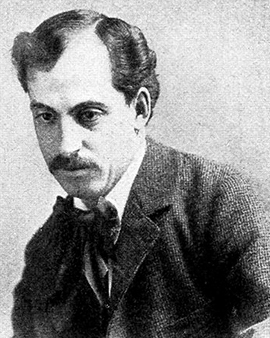


William Bradley's illustrations are the perfect visualization of the exciting atmosphere in turn-of-the-century America. Like so much else in that era, the art world was completely disrupted by revolutionary inventions and industrialization. New printing techniques allowed illustrations to be reproduced endlessly, making art more accessible to the public. It no longer took place only in museums, but in magazines and on the walls of cafés and salons. In the late 1890's, the Art Nouveau style - also called Art Nouveau - spread throughout the Western world. It was daring, adventurous and broke with old artistic traditions. Conservative oil paintings were replaced by printed posters. Young artists drew inspiration from other cultures, social change, and modern technological possibilities.
Bradley was inspired by this style from Europe and established it in North America during his career. He is still known there today as its most famous exponent. Bradley designed cover art for magazines, designed illustrations and advertising posters, and launched his own art magazine on the side. He must have had a very conscientious work ethic to oversee so many projects at once. Not for nothing did he become the highest paid artist of his time. His seemingly insatiable energy also speaks from his art. His paintings, despite their flat poster style, are incredibly vibrant and daring. Bradley not only paved the way for the spread of Art Nouveau in North America, but also developed his own modified version of the European style. This left its mark on the art and advertising world in the States for many decades.
As was common for Art Nouveau, Bradley's illustrations are usually dominated by two to three colors. The borders are decorated with flowers and vines. All elements of his motifs literally dance around each other and blur into complex compositions. The proportions of the people and plants are often distorted and surreal. Sometimes the stylized figures look confident and challenging, ready for an exciting future, and sometimes they seem dreamy and mystical. They are always surrounded by plants, flowers, and geometric shapes, and seem to move fluidly. Bradley's illustrations exude curiosity and confidence.
In general, Art Nouveau artists were oriented toward nature while having a strong fascination with the technical possibilities of modernism. They strove for a harmony between the two worlds. The artists were not concerned with depicting the world realistically, but rather wanted to bring out the essence of nature and man. Due to the peculiarities of the lithography printing technique, they had to work with clear, simple lines and sharp contrasts. This reduced each element in the illustrations to its essential features. Nevertheless, these geometric shapes appear natural and dynamic. While the creative possibilities in printing are more limited than in painting, Bradley and his contemporaries proved that this technique can be just as inspiring and creative.

William Bradley's illustrations are the perfect visualization of the exciting atmosphere in turn-of-the-century America. Like so much else in that era, the art world was completely disrupted by revolutionary inventions and industrialization. New printing techniques allowed illustrations to be reproduced endlessly, making art more accessible to the public. It no longer took place only in museums, but in magazines and on the walls of cafés and salons. In the late 1890's, the Art Nouveau style - also called Art Nouveau - spread throughout the Western world. It was daring, adventurous and broke with old artistic traditions. Conservative oil paintings were replaced by printed posters. Young artists drew inspiration from other cultures, social change, and modern technological possibilities.
Bradley was inspired by this style from Europe and established it in North America during his career. He is still known there today as its most famous exponent. Bradley designed cover art for magazines, designed illustrations and advertising posters, and launched his own art magazine on the side. He must have had a very conscientious work ethic to oversee so many projects at once. Not for nothing did he become the highest paid artist of his time. His seemingly insatiable energy also speaks from his art. His paintings, despite their flat poster style, are incredibly vibrant and daring. Bradley not only paved the way for the spread of Art Nouveau in North America, but also developed his own modified version of the European style. This left its mark on the art and advertising world in the States for many decades.
As was common for Art Nouveau, Bradley's illustrations are usually dominated by two to three colors. The borders are decorated with flowers and vines. All elements of his motifs literally dance around each other and blur into complex compositions. The proportions of the people and plants are often distorted and surreal. Sometimes the stylized figures look confident and challenging, ready for an exciting future, and sometimes they seem dreamy and mystical. They are always surrounded by plants, flowers, and geometric shapes, and seem to move fluidly. Bradley's illustrations exude curiosity and confidence.
In general, Art Nouveau artists were oriented toward nature while having a strong fascination with the technical possibilities of modernism. They strove for a harmony between the two worlds. The artists were not concerned with depicting the world realistically, but rather wanted to bring out the essence of nature and man. Due to the peculiarities of the lithography printing technique, they had to work with clear, simple lines and sharp contrasts. This reduced each element in the illustrations to its essential features. Nevertheless, these geometric shapes appear natural and dynamic. While the creative possibilities in printing are more limited than in painting, Bradley and his contemporaries proved that this technique can be just as inspiring and creative.
Page 1 / 1






